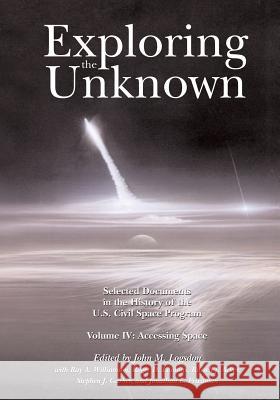Exploring the Unknown: Selected Documents in the History of the U.S. Civil Space Program, Volume IV: Accessing Space » książka
Exploring the Unknown: Selected Documents in the History of the U.S. Civil Space Program, Volume IV: Accessing Space
ISBN-13: 9781495405570 / Angielski / Miękka / 2014 / 718 str.
Exploring the Unknown: Selected Documents in the History of the U.S. Civil Space Program, Volume IV: Accessing Space
ISBN-13: 9781495405570 / Angielski / Miękka / 2014 / 718 str.
(netto: 102,87 VAT: 5%)
Najniższa cena z 30 dni: 108,01
ok. 16-18 dni roboczych
Bez gwarancji dostawy przed świętami
Darmowa dostawa!
One of the most important developments of the twentieth century has been the movement of humanity into space with machines and people. The underpinnings of that movement-why it took the shape it did; which individuals and organizations were involved; what factors drove a particular choice of scientific objectives and technologies to be used; and the political, economic, managerial, and international contexts in which the events of the space age unfolded-are all important ingredients of this epoch transition from an Earthbound to a spacefaring people. This desire to understand the development of spaceflight in the United States sparked this documentary history series. The extension of human activity into outer space has been accompanied by a high degree of self-awareness of its historical significance. Few large-scale activities have been as extensively chronicled so closely to the time they actually occurred. Many of those who were directly involved were quite conscious that they were making history, and they kept full records of their activities. Because most of the activity in outer space was carried out under government sponsorship, it was accompanied by the documentary record required of public institutions, and there has been a spate of official and privately written histories of most major aspects of space achievement to date. When top leaders considered what course of action to pursue in space, their deliberations and decisions often were carefully put on the record. There is, accordingly, no lack of material for those who aspire to understand the origins and evolution of U.S. space policies and programs. This reality forms the rationale for this series. Precisely because there is so much historical material available on space matters, the National Aeronautics and Space Administration (NASA) decided in 1988 that it would be extremely useful to have a selective collection of many of the seminal documents related to the evolution of the U.S. civilian space program that was easily available to scholars and the interested public. While recognizing that much space activity has taken place under the sponsorship of the Department of Defense and other national security organizations, within the U.S. private sector, and in other countries around the world, NASA felt that there would be lasting value in a collection of documentary material primarily focused on the evolution of the U.S. government's civil space program, most of which has been carried out since 1958 under the agency's auspices. As a result, the NASA History Office contracted with the Space Policy Institute of George Washington University's Elliott School of International Affairs to prepare such a collection. This is the fourth volume in the documentary history series; two additional ones detailing programmatic developments with respect to space science and human spaceflight will follow. The documents selected for inclusion in this volume are presented in four major chapters, each covering a particular aspect of access to space and the manner in which it has developed over time. These chapters focus on the evolution toward the giant Saturn V rocket, the development of the Space Shuttle, space transportation commercialization, and future space transportation possibilities. Volume I in this series covered the antecedents to the U.S. space program, as well as the origins and evolution of U.S. space policy and of NASA as an institution. Volume II addressed the relations between the U.S. civil space program and the space activities of other countries, between the U.S. civil program and national security space and military efforts, and between NASA and industry and academic institutions. Volume III provided documents on satellite communications, remote sensing, and the economic of space applications. As mentioned above, the remaining two volumes of the series will cover space science and human spaceflight.
Zawartość książki może nie spełniać oczekiwań – reklamacje nie obejmują treści, która mogła nie być redakcyjnie ani merytorycznie opracowana.











